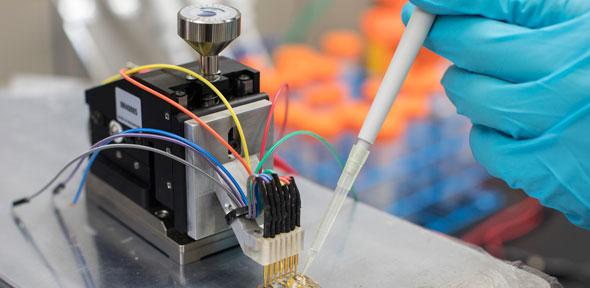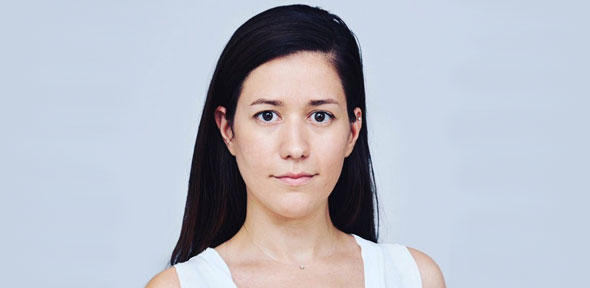Clik here to view.

The sensor can measure the amount of critical metabolites, such as lactate or glucose, that are present in sweat, tears, saliva or blood, and, when incorporated into a diagnostic device, could allow health conditions to be monitored quickly, cheaply and accurately. The new device has a far simpler design than existing sensors, and opens up a wide range of new possibilities for health monitoring down to the cellular level. The results are reported in the journal Science Advances.
The device was developed by a team led by the University of Cambridge and King Abdullah University of Science and Technology (KAUST) in Saudi Arabia. Semiconducting plastics such as those used in the current work are being developed for use in solar cells and flexible electronics, but have not yet seen widespread use in biological applications.
“In our work, we’ve overcome many of the limitations of conventional electrochemical biosensors that incorporate enzymes as the sensing material,” said lead author Dr Anna-Maria Pappa, a postdoctoral researcher in Cambridge’s Department of Chemical Engineering and Biotechnology. “In conventional biosensors, the communication between the sensor’s electrode and the sensing material is not very efficient, so it’s been necessary to add molecular wires to facilitate and ‘boost’ the signal.”
To build their sensor, Pappa and her colleagues used a newly-synthesised polymer developed at Imperial College that acts as a molecular wire, directly accepting the electrons produced during electrochemical reactions. When the material comes into contact with a liquid such as sweat, tears or blood, it absorbs ions and swells, becoming merged with the liquid. This leads to significantly higher sensitivity compared to traditional sensors made of metal electrodes.
Additionally, when the sensors are incorporated into more complex circuits, such as transistors, the signal can be amplified and respond to tiny fluctuations in metabolite concentration, despite the tiny size of the devices.
Initial tests of the sensors were used to measure levels of lactate, which is useful in fitness applications or to monitor patients following surgery. However, according to the researchers, the sensor can be easily modified to detect other metabolites, such as glucose or cholesterol by incorporating the appropriate enzyme, and the concentration range that the sensor can detect can be adjusted by changing the device’s geometry.
“This is the first time that it’s been possible to use an electron accepting polymer that can be tailored to improve communication with the enzymes, which allows for the direct detection of a metabolite: this hasn’t been straightforward until now,” said Pappa. “It opens up new directions in biosensing, where materials can be designed to interact with a specific metabolite, resulting in far more sensitive and selective sensors.”
Since the sensor does not consist of metals such as gold or platinum, it can be manufactured at a lower cost and can be easily incorporated in flexible and stretchable substrates, enabling their implementation in wearable or implantable sensing applications.
“An implantable device could allow us to monitor the metabolic activity of the brain in real time under stress conditions, such as during or immediately before a seizure and could be used to predict seizures or to assess treatment,” said Pappa.
The researchers now plan to develop the sensor to monitor metabolic activity of human cells in real time outside the body. The Bioelectronic Systems and Technologies group where Pappa is based is focused on developing models that can closely mimic our organs, along with technologies that can accurately assess them in real-time. The developed sensor technology can be used with these models to test the potency or toxicity of drugs.
The research was funded by the Marie Curie Foundation, the KAUST Office of Sponsored Research, and the Engineering and Physical Sciences Research Council.
Reference:
A.M. Pappa et al. ‘Direct metabolite detection with an n-type accumulation mode organic electrochemical transistor.’ Science Advances (2018). DOI: 10.1126/sciadv.aat0911
An international team of researchers have developed a low-cost sensor made from semiconducting plastic that can be used to diagnose or monitor a wide range of health conditions, such as surgical complications or neurodegenerative diseases.
Image may be NSFW.
Clik here to view.
I strongly believe that through diversity comes creativity, comes progress. I qualified as an engineer, and later earned my Master’s degree at Aristotle University of Thessaloniki in Greece. My PhD is in Bioelectronics from École des Mines de Saint-Étienne in France and leaving my comfort zone to study abroad proved to be an invaluable experience. I met people from different cultures and mindsets from all over the world, stretched my mind and expanded my horizons.
Now, I always look for those with different views. I travel frequently for conferences and visit other laboratories across Europe, the United States and Saudi Arabia. When you work in a multidisciplinary field it is essential to establish and keep good collaborations: this is the only way to achieve the desired outcome.
Being part of a University where some of the world's most brilliant scientists studied and worked is a great privilege. Cambridge combines a historic and traditional atmosphere with cutting-edge research in an open, multicultural society. The state-of-the-art facilities, the openness in innovation and strong collaborations provide a unique combination that can only lead to excellence.
As an engineer, creating solutions to important yet unresolved issues for healthcare is what truly motivates me. I’m working on a drug discovery platform using bioelectronics, and my work sets out to improve and accelerate drug discovery by providing novel technological solutions for drug screening and disease management. I hope my research will lead to a product that will impact healthcare. In the future, I imagine a healthcare system where the standard one-size-fits-all approach shifts to a more personalised and tailored model.
I’m a strong advocate for Women in STEMM, and in October 2017 I was awarded a L'Oréal-UNESCO For Women in Science Fellowship, an award that honours the contributions of women in science. For me, the award not only represents a scientific distinction but also gives me the unique opportunity, as an ambassador of science, to inspire and motivate young girls to follow the career they desire.
I think it’s absolutely vital, at every opportunity, for all of us to honour and promote girls and women in science. Unfortunately, women still struggle when it comes to joining male-dominated fields, and even to establish themselves later at senior roles. We still face stereotypes and social restrictions, even if it is not as obvious today as it was in the past. A question I always ask girls during my outreach activities at schools, is, ‘do I look like a scientist?’, and the answer I most often get is no! I think this misperception of what STEMM professionals look like, or of what they actually do on a daily basis is what discourages girls early on to follow STEMM careers. This needs to change.
Image may be NSFW.
Clik here to view.
The text in this work is licensed under a Creative Commons Attribution 4.0 International License. Images, including our videos, are Copyright ©University of Cambridge and licensors/contributors as identified. All rights reserved. We make our image and video content available in a number of ways – as here, on our main website under its Terms and conditions, and on a range of channels including social media that permit your use and sharing of our content under their respective Terms.